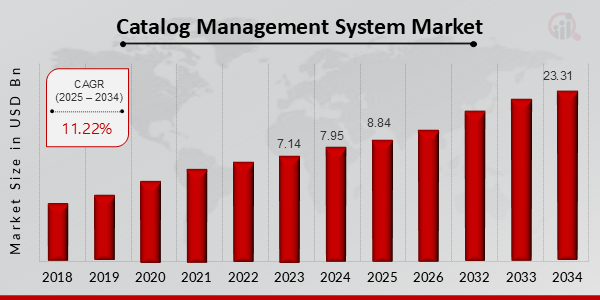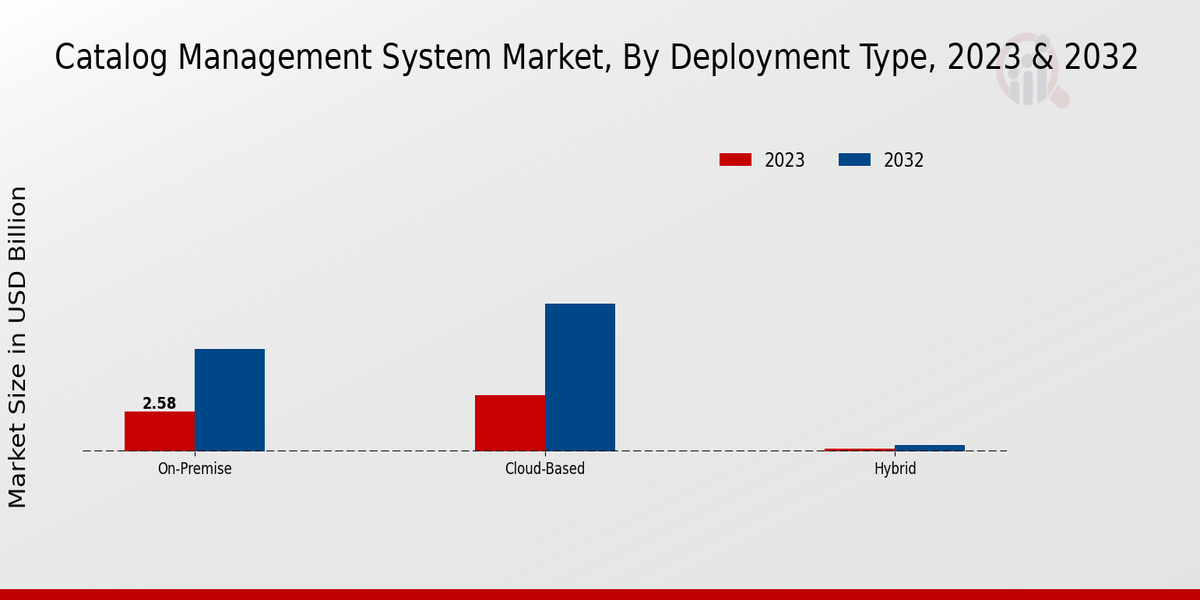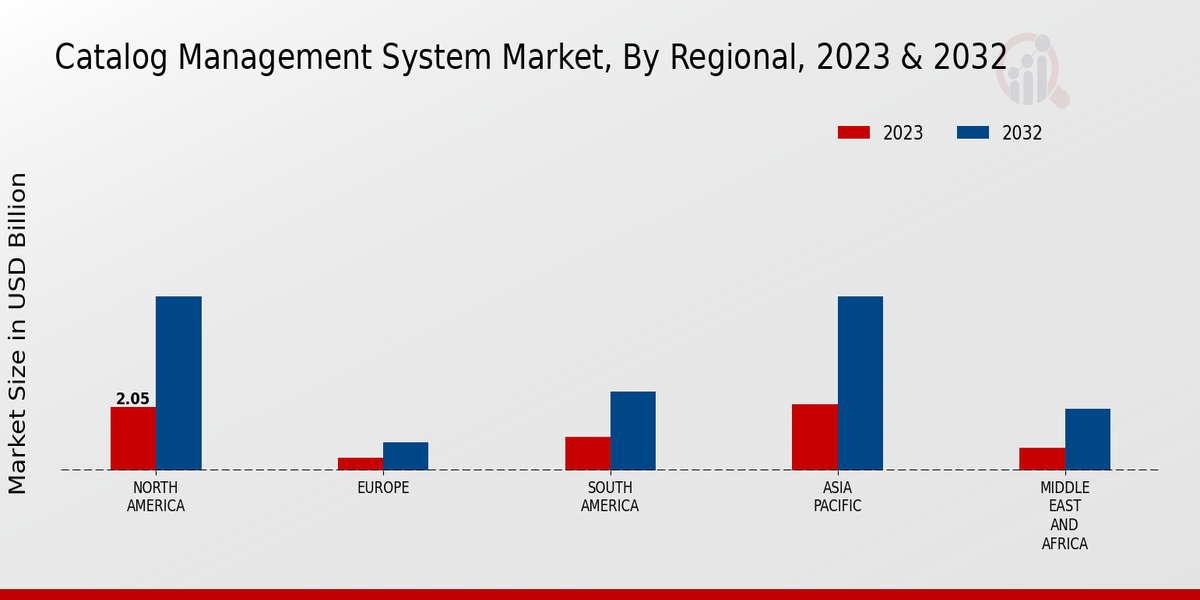Catalog Management System Market Overview
Catalog Management System Market is projected to grow from USD 8.84 Billion in 2025 to USD 23.31 Billion by 2034, exhibiting a compound annual growth rate (CAGR) of 11.22% during the forecast period (2025 - 2034). Additionally, the market size for Catalog Management System Market was valued at USD 7.95 billion in 2024.
Key Catalog Management System Market Trends Highlighted
An evolving e-commerce industry, increased product complexity, and the need to optimize customer experience are driving the growth of the catalog management system market.These systems empower businesses to efficiently create, manage, and distribute product catalogs across multiple channels, ensuring consistency and accuracy.Opportunities abound in the market with the rise of headless commerce and the need for personalized catalogs. Headless commerce enables businesses to decouple the front and back end of their e-commerce platforms, allowing for greater flexibility and customization.Personalized catalogs, tailored to individual customer preferences, enhance engagement and drive conversions.
Recent trends in the market include the adoption of cloud-based solutions, the integration of artificial intelligence (AI) and machine learning (ML) capabilities, and the focus on omnichannel catalog management. Cloud-based systems offer scalability, cost-effectiveness, and easy access.AI/ML technologies automate catalog management tasks, improving efficiency and accuracy. Omnichannel catalog management ensures a seamless customer experience across all touchpoints.By leveraging these trends and addressing the key market drivers, businesses can effectively manage their catalogs, streamline operations, and drive growth in the competitive landscape.
Fig 1 Catalog Management System Market Overview (2025-2034)

Source: Primary Research, Secondary Research, MRFR Database and Analyst Review
Catalog Management System Market Drivers
Rising Adoption of E-commerce and Omnichannel Retailing
With the expansion of e-commerce and omnichannel trade, the relevance of efficient catalog management systems has increased significantly.Businesses that strive to ensure frictionless and consistent shopping experiences across all types of channels require suitable systems to manage their product catalog correctly.In proportion to this need, catalog management systems are designed to help businesses integrate their product data, reduce mistakes and inconsistencies, and simplify access to relevant information.As a result, catalog management systems help to enhance customer satisfaction, reduce operational costs, and deliver sales growth.Because the popularity of e-commerce and omnichannel trade is expected to grow in the foreseeable future, the demand for catalog management systems is likely to increase as well.
Increasing Product Complexity and Customization
The complexity and personalization of products in many industries have grown, making the appropriate abilities implemented by businesses mandatory.In many situations, there are more variants, configurations, and means of creating unique products for individual buyers, and for businesses, the traditional method of utilizing these factors to be more appealing and user-friendly became inefficient.
Catalog management systems can help businesses find the possibilities of integrating complex product structures, demand usage of tens of product attributes, and provide greater levels of specificity in terms of recommendations and other tools used to showcase products and attract customers.For this reason, the trend of increased differentiation and personalization of products is likely to result in greater demand for more sophisticated catalog management systems in the Catalog Management System Market.
Growing Need for Data Analytics and Personalization
Since marketing and sales are becoming more and more dependent on data analytics and personalization, catalog management systems have become even more indispensable than they were before.Specifically, CMS helps gather client information, analyze it in the context of the existing market or markets, and create a comprehensive picture of customer behavior and expectations.
By delivering the identified information to CRM and marketing automation systems, a CMS allows for creating an opportunity for personalized product suggestions, special offers for target audiences, and a range of other customized options for shopping.Therefore, the identified innovation is expected to help businesses manage their promotion and sales even more efficiently.As a result, the increasing demand for data analytics and personalization is expected to fuel the growth of the Catalog Management System Market, thus adding to the above-mentioned growth opportunities.
Catalog Management System Market Segment Insights
Catalog Management System Market Deployment Type Insights
The Catalog Management System Market segmentation by deployment type includes on-premises, cloud-based, and hybrid. The cloud-based segment is expected to dominate the market, due to its advantages such as scalability, flexibility, and cost.In addition, the cloud-based deployment model does not require companies to invest in hardware and software infrastructure, which is beneficial for small and medium-sized enterprises.The market for cloud-based catalog management systems is expected to benefit from the increasing adoption of cloud computing services, as well as the increasing adoption of Software as a Service deployment.
The on-premises segment is also expected to increase its market share; at the same time, its growth is expected to be lower compared to the cloud-based segment.The growth of the on-premises segment will be facilitated by the fact that companies are expected to maintain a preference for their catalog systems and data.The hybrid segment, in turn, which combines the advantages of on-premises and cloud-based deployments, is also expected to grow, but its growth pace is expected to be low.Overall, the Catalog Management System Market is expected to grow in the next few years; the cloud-based deployment model is expected to dominate the market, while on-premises and hybrid segments are expected to contribute to the market growth.
Fig 2 Catalog Management System Market Deployment Type (2023-2032)

Source: Primary Research, Secondary Research, MRFR Database and Analyst Review
Catalog Management System Market Organization Size Insights
The Catalog Management System Market segmentation by Organization Size includes Small and Medium-sized Enterprises (SMEs) and Large Enterprises.SMEs are projected to hold a significant share of the market due to the increasing adoption of digital technologies to streamline their operations and improve customer engagement.The growing need for efficient product information management and the affordability of catalog management solutions are driving the growth in this segment.
On the other hand, large enterprises are expected to witness substantial growth owing to their complex product portfolios and the need for robust catalog management systems to manage vast amounts of product data.They invest heavily in advanced catalog management solutions to enhance their customer experience, personalize marketing campaigns, and optimize supply chain efficiency.As a result, the Catalog Management System Market is expected to witness a surge in demand from both SMEs and large enterprises, contributing to the overall market growth.
Catalog Management System Market Vertical Insights
The Catalog Management System Market segmentation by Industry Vertical includes Retail, Manufacturing, Healthcare, Financial Services, Government, and Education.Retail holds the largest market share due to the increasing need for efficient product information management and omnichannel retailing. In 2023, the retail segment was valued at USD 2.4 billion and is projected to reach USD 6.2 billion by 2032, exhibiting a CAGR of 11.8%.
Manufacturing is another significant segment, driven by the need for centralized product data management and compliance with industry regulations.The healthcare segment is growing rapidly due to the increasing adoption of electronic health records and the need for accurate and up-to-date product information for patient safety.Financial services, government, and education are other key industry verticals that are adopting catalog management systems to improve efficiency, reduce costs, and enhance customer service.
Catalog Management System Market Core Features Insights
The Catalog Management System Market is segmented by Core Features into Product Data Management, Image Management, Content Management, Asset Management, and Marketing Campaign Management.The Product Data Management segment is expected to account for the largest share of the market in 2023. This is due to the increasing need for businesses to manage and organize their product data in order to improve product quality and customer satisfaction.
The Image Management segment is also expected to grow significantly as businesses increasingly use images to market their products and services.The Content Management segment is also expected to grow as businesses increasingly use content to engage with customers and build brand awareness.The Asset Management segment is expected to grow, as businesses increasingly need to manage their digital assets in order to improve efficiency and reduce costs.The Marketing Campaign Management segment is also expected to grow as businesses increasingly use marketing campaigns to reach their target audience.
Catalog Management System Market Pricing Model Insights
The pricing model segment is a key factor in determining the growth of the Catalog Management System Market revenue. The two main pricing models in the market are subscription-based and perpetual license. The subscription-based model is gaining popularity due to its flexibility and affordability.In this model, customers pay a recurring fee to access the software on a subscription basis. This model allows customers to scale their usage up or down as needed, and it provides them with access to the latest features and updates.The perpetual license model, on the other hand, involves a one-time payment for a perpetual license to use the software.
his model is typically more expensive than the subscription-based model, but it provides customers with the advantage of owning the software outright.In 2023, the subscription-based model accounted for the largest share of the Catalog Management System Market data, and it is expected to continue to grow at a faster rate than the perpetual license model in the coming years.This growth is being driven by the increasing adoption of cloud-based software and the growing popularity of the as-a-service model. Overall, the pricing model segment is a key factor to consider when evaluating the Catalog Management System Market.The choice of pricing model will depend on a number of factors, including the size of the organization, the budget, and the specific needs of the business.
Catalog Management System Market Regional Insights
The Catalog Management System Market segmentation by region offers insights into the market's geographical distribution and growth potential.North America is expected to dominate the market with a significant market share due to the presence of major technology hubs and the early adoption of advanced technologies. Europe follows closely, driven by government initiatives and regulations favoring digital transformation.APAC is anticipated to witness substantial growth, fueled by the increasing adoption of e-commerce and digitalization in emerging economies.South America and MEA are expected to contribute a growing share of the global market as businesses in these regions embrace digitalization and seek improved operational efficiency.
Fig 3 Catalog Management System Market Regional Insights(2023-2032)

Source: Primary Research, Secondary Research, MRFR Database and Analyst Review
Catalog Management System Market Key Players and Competitive Insights
Major players in the Catalog Management System Market are constantly trying to outdo each other by introducing new features and functionalities to their products. Leading Catalog Management System Market players are investing heavily in research and development to stay ahead of the competition.The Catalog Management System Market development is being driven by the increasing need for businesses to manage their product catalogs effectively.The Catalog Management System Market Competitive Landscape is expected to remain competitive in the coming years, with new players entering the market and existing players expanding their product offerings.
One of the leading companies in the Catalog Management System Market is InRiver. InRiver provides a cloud-based catalog management solution that helps businesses create, manage, and publish their product catalogs.InRiver's solution is used by a variety of businesses, including manufacturers, retailers, and distributors. InRiver has a strong track record of innovation and has been recognized as a leader in the Catalog Management System Market.Another major player in the Catalog Management System Market is Stibo Systems.
Stibo Systems provides a comprehensive suite of catalog management solutions that help businesses manage their product information, create catalogs, and publish them to a variety of channels.Stibo Systems' solutions are used by a variety of businesses, including manufacturers, retailers, and distributors. Stibo Systems has a strong focus on customer satisfaction and has been recognized for its commitment to providing high-quality products and services.
Key Companies in the Catalog Management System Market Include
- Syndigo
- Salsify
- IBM Sterling Catalog Management
- Akeneo PIM
- eSpirit
- PIMCore
- Perfion
- SAP Hybris Commerce Cloud
- Riversand
- Stibo Systems
- Contentserv
- Oracle CX Unity
- Informatica Master Data Management
- A10X
- ChannelAdvisor
Catalog Management System Market Developments
The growth of the market is attributed to the increasing adoption of e-commerce, the need for efficient product information management, and the growing popularity of omnichannel retailing.Key industry participants include SAP SE, Oracle Corporation, IBM Corporation, Informatica Corporation, and OpenText Corporation.These companies are focusing on developing innovative solutions to meet the evolving needs of customers. For instance, in 2023, SAP introduced a new version of its CMS, SAP Product Master, which includes enhanced features for product data management and syndication.
The increasing adoption of cloud-based CMS solutions is another key trend in the market. Cloud-based solutions offer several benefits, such as scalability, flexibility, and cost-effectiveness. As a result, many businesses are migrating their CMS to the cloud.Overall, the Catalog Management System Market is poised for significant growth in the coming years. The increasing adoption of e-commerce, the need for efficient product information management, and the growing popularity of omnichannel retailing are the major factors driving the growth of the market.
Catalog Management System Market Segmentation Insights
-
Catalog Management System Market Deployment Type Outlook
- On-premises
- Cloud-based
- Hybrid
-
Catalog Management System Market Organization Size Outlook
- Small and Medium-sized Enterprises (SMEs)
- Large Enterprises
-
Catalog Management System Market Vertical Outlook
- Retail
- Manufacturing
- Healthcare
- Financial Services
- Government
- Education
-
Catalog Management System Market Core Features Outlook
- Product Data Management
- Image Management
- Content Management
- Asset Management
- Marketing Campaign Management
-
Catalog Management System Market Pricing Model Outlook
- Subscription-based
- Perpetual License
-
Catalog Management System Market Regional Outlook
- North America
- Europe
- South America
- Asia Pacific
- Middle East and Africa
|
Report Attribute/Metric
|
Details
|
|
Market Size 2024
|
7.95 (USD Billion)
|
|
Market Size 2025
|
8.84 (USD Billion)
|
|
Market Size 2034
|
23.31 (USD Billion)
|
|
Compound Annual Growth Rate (CAGR)
|
11.22% (2025 - 2034)
|
|
Report Coverage
|
Revenue Forecast, Competitive Landscape, Growth Factors, and Trends
|
|
Base Year
|
2024
|
|
Market Forecast Period
|
2025 - 2034
|
|
Historical Data
|
2019 - 2023
|
|
Market Forecast Units
|
USD Billion
|
|
Key Companies Profiled
|
Syndigo, Salsify, IBM Sterling Catalog Management, Akeneo PIM, eSpirit, PIMCore, Perfion, SAP Hybris Commerce Cloud, Riversand, Stibo Systems, Contentserv, Oracle CX Unity, Informatica Master Data Management, A10X, ChannelAdvisor
|
|
Segments Covered
|
Deployment Type, Organization Size, Industry Vertical, Core Features, Pricing Model, Regional
|
|
Key Market Opportunities
|
Evolving demand for personalized content Cloud-based deployments for scalability Integration with AI and ML for improved search Expansion into emerging markets Growing adoption in the e-commerce industry
|
|
Key Market Dynamics
|
Rising adoption of cloud-based solutions, increasing demand for centralized product information management, the growing e-commerce industry, technological advancements, enhancing functionality, and increasing need for data analytics and personalization
|
|
Countries Covered
|
North America, Europe, APAC, South America, MEA
|
Frequently Asked Questions (FAQ) :
The Catalog Management System Market was valued at 7.95 billion U.S. dollars in 2024 and is projected to reach around 23.31 billion U.S. dollars by the end of 2034, exhibiting a compound annual growth rate (CAGR) of approximately 11.22% during the forecast period.
North America is expected to dominate the Catalog Management System Market throughout the forecast period owing to the presence of a large number of established vendors and early adoption of advanced technologies in the region.
The growth of the Catalog Management System market is primarily driven by the increasing need for efficient product catalog management, the rising adoption of e-commerce platforms, and the growing popularity of omnichannel retailing.
Catalog Management Systems find applications in various industries, including retail, manufacturing, healthcare, and education. They are used to manage product catalogs, create and distribute marketing materials, and track customer orders.
Some of the key competitors in the Catalog Management System market include SAP, Oracle, IBM, Adobe, and OpenText.
The Asia-Pacific region is expected to witness the fastest growth in the Catalog Management System market during the forecast period, with a CAGR of approximately 11.22% .
The Catalog Management System market faces challenges such as data integration issues, the need for skilled professionals, and the increasing complexity of product catalogs.
Some of the emerging trends in the Catalog Management System market include the adoption of cloud-based solutions, the use of artificial intelligence (AI), and the integration of augmented reality (AR).
The COVID-19 pandemic had a significant impact on the Catalog Management System market, leading to a decline in demand due to disruptions in supply chains and business operations. However, the market is expected to recover and continue its growth trajectory in the post-pandemic period.
Key opportunities for growth in the Catalog Management System market include the expansion of e-commerce, the increasing adoption of digital technologies, and the growing demand for personalized customer experiences.

















